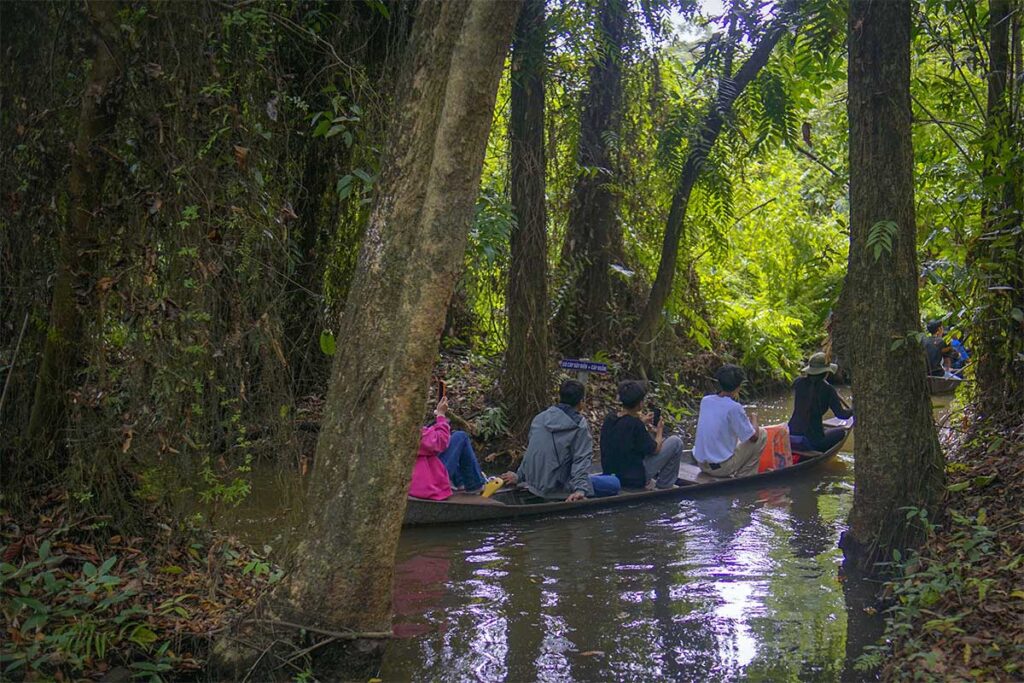What is Xeo Quyt Forest?
Location & Scenery
Xeo Quyt Forest is about 35 km southeast of Cao Lanh, close to My Hiep Commune in Dong Thap Province. The protected area covers 52 hectares, of which 20 hectares are dense cajuput forest.
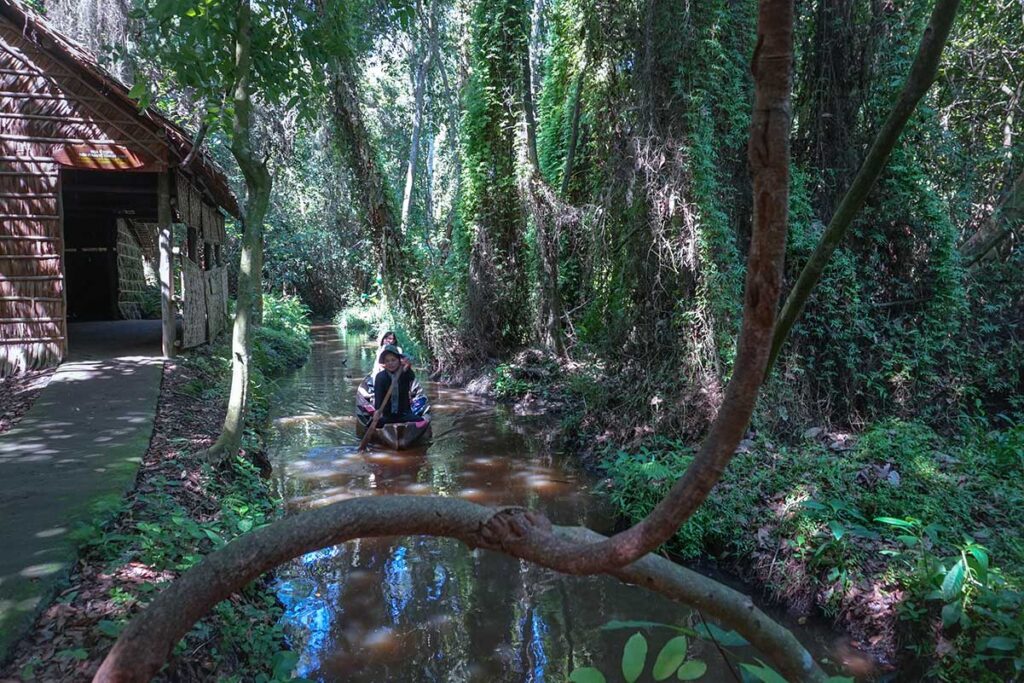
The landscape is a mix of narrow canals, lotus ponds, and shaded walking trails. Visitors usually explore the forest either by sampan boat or along simple pathways and wooden bridges that cut through the swamp. The setting feels peaceful, though it is more about quiet scenery than dramatic views.
History of Xeo Quyt
From 1960 to 1975, Xeo Quyt served as a secret revolutionary base during the Vietnam War. Hidden beneath the forest canopy were underground bunkers, meeting rooms, and living quarters used by high-ranking Viet Cong officers. The site was only 2 km from a major US military base, yet the network of tunnels and shelters remained undiscovered throughout the conflict. Today, you can still see these bunkers and reconstructed huts, which offer a glimpse into how soldiers lived and operated here. Xeo Quyt was officially recognized as a national historical relic in 1992.
Nature & Ecosystem
Beyond its history, Xeo Quyt is also an ecological zone. The forest contains more than 170 plant species and around 200 species of animals, including reptiles and birds. Thirteen species are listed in Vietnam’s Red Data Book, such as pythons and otters, though spotting them during a visit is rare.
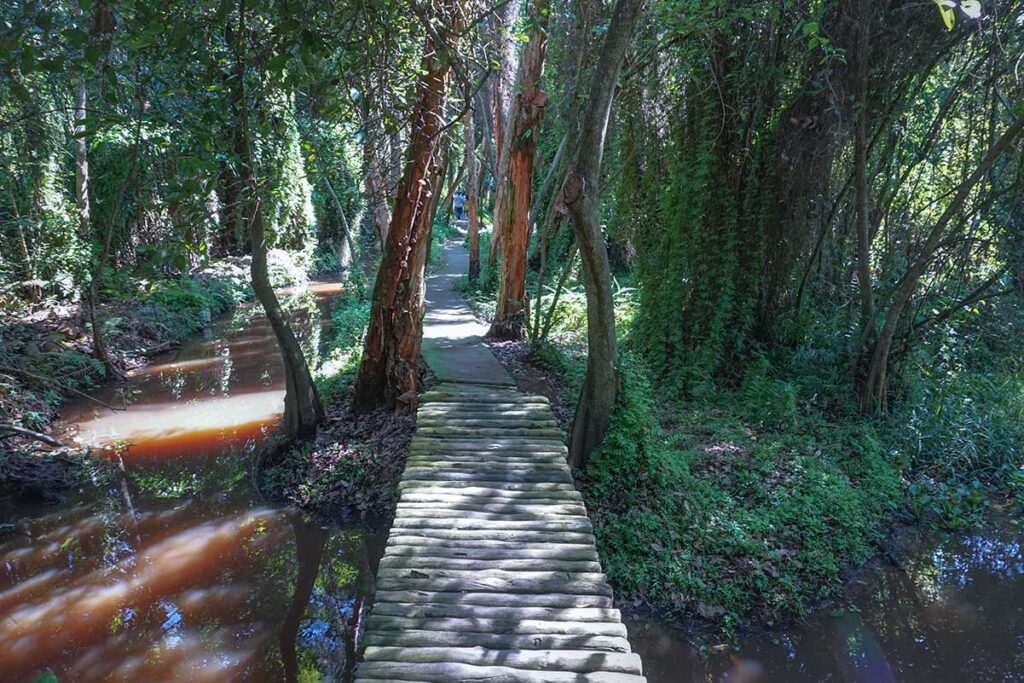
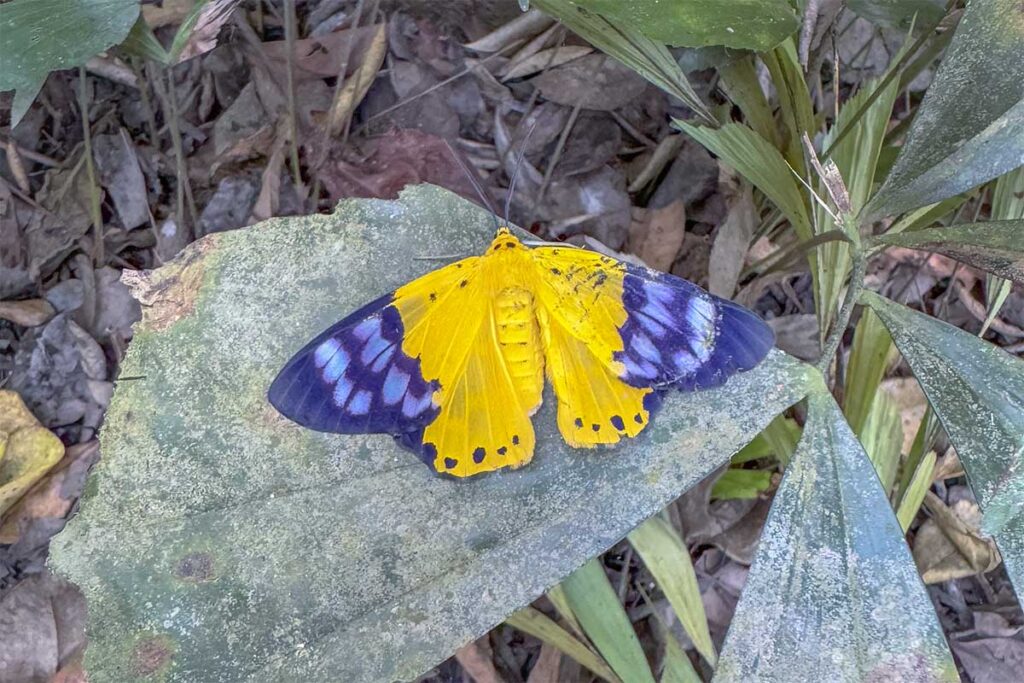
Seasonal changes make a difference to the scenery: lotus ponds are most photogenic when blooming, while the flooding season in October and November gives the canals a wilder, more atmospheric look.
Highlights of visiting Xeo Quyt Forest
1. Sampan boat ride
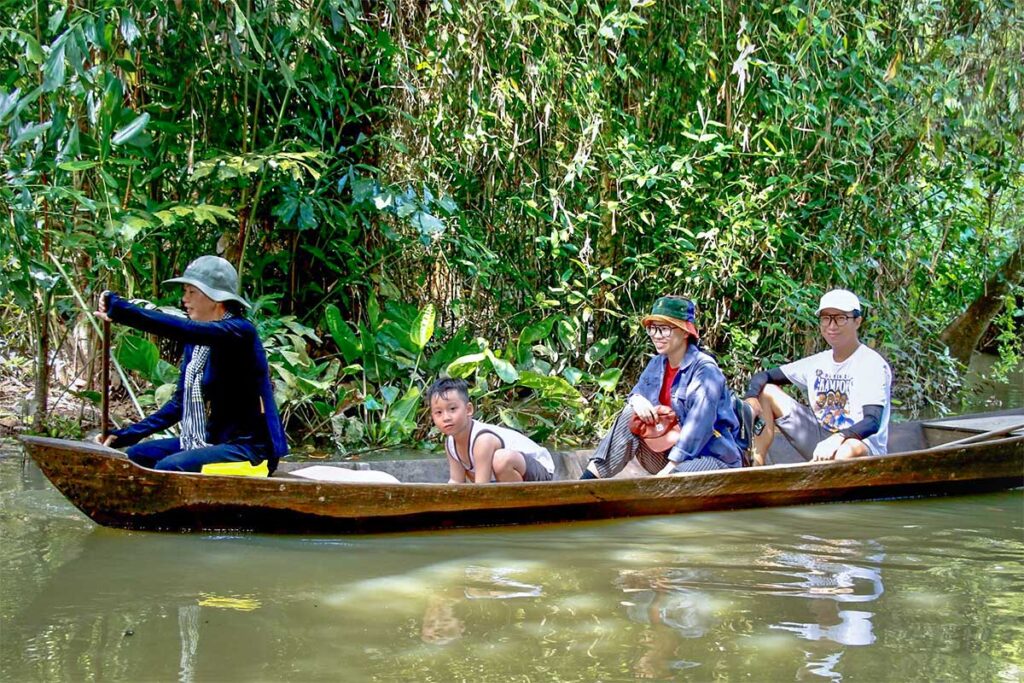
One of the main experiences at Xeo Quyt is a short sampan ride through the forest canals. The trip usually lasts 20–30 minutes and costs between 25,000 and 50,000 VND per person, depending on the boat. As you glide through narrow waterways shaded by cajuput trees, you pass old bunker sites and vine-covered trees. It’s calm and atmospheric, but don’t expect much in the way of wildlife — the appeal here is the scenery and the sense of stepping into a hidden corner of the Mekong Delta.
2. Forest Trails & Observation Tower
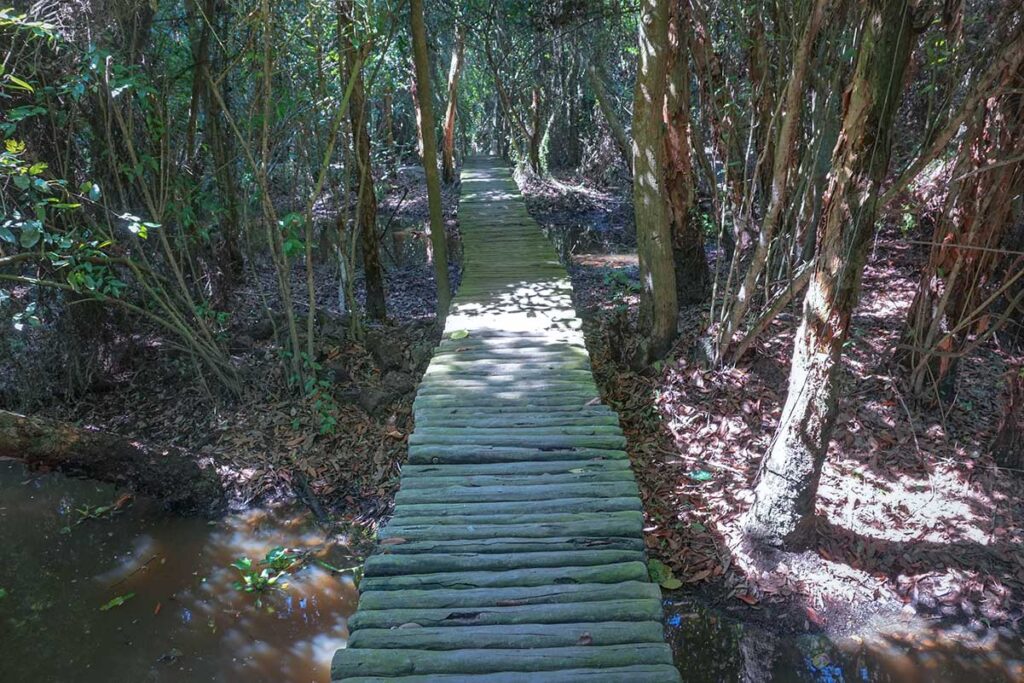
If you prefer exploring on foot, there are about 1.5 to 2.5 km of simple walking paths through the forest. The trails include rustic wooden bridges and shaded stretches under the tall trees, making it pleasant for a slow walk.
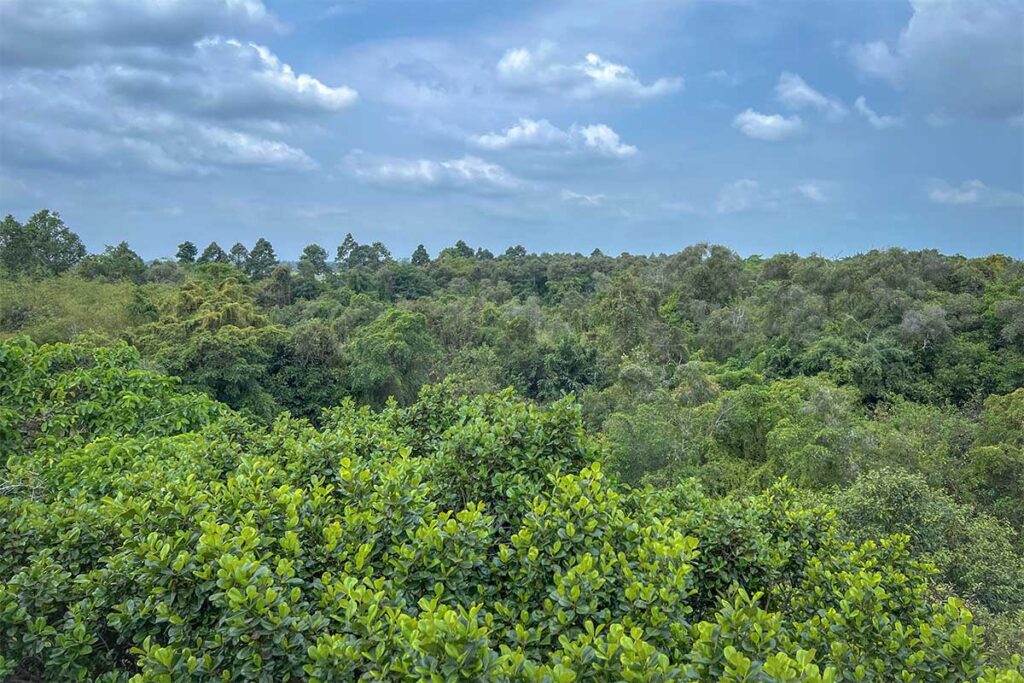
There is also a small observation tower that lets you look out over the canopy, though it’s more for appreciating the forest from above than for birdwatching. The paths can get muddy in the wet season, so decent walking shoes are a good idea.
3. Vietnam War Relics
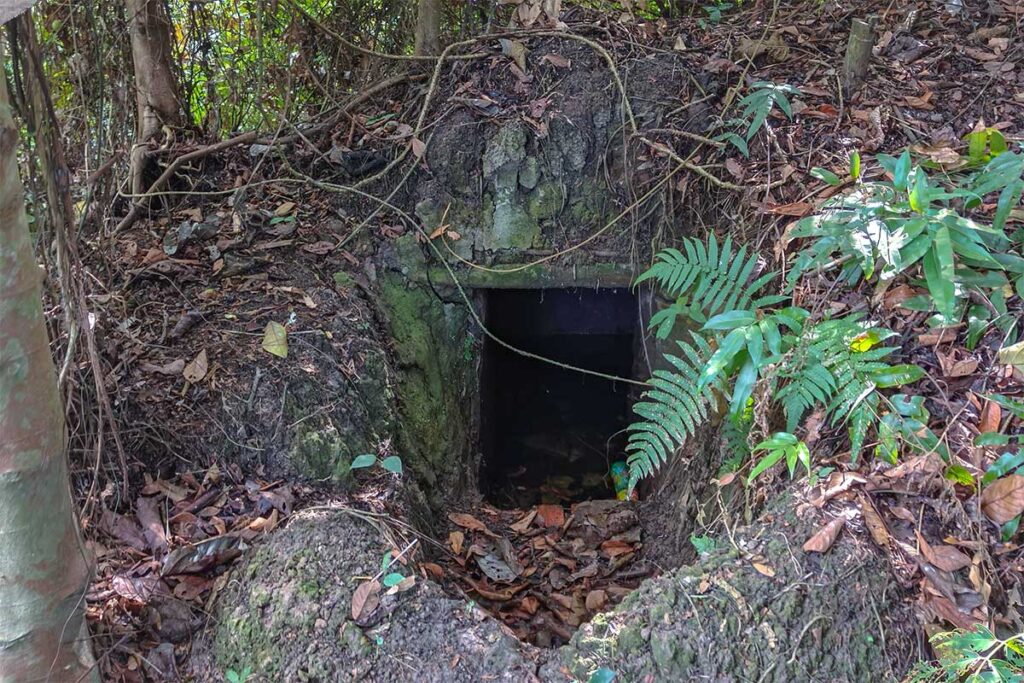
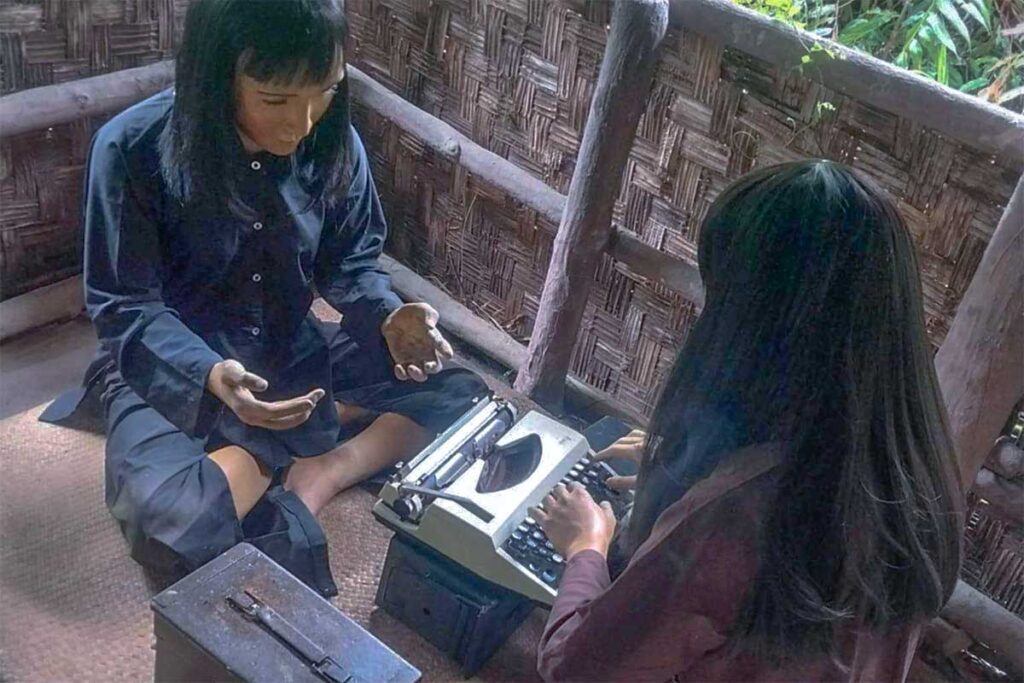
The historical side of Xeo Quyt is found in its bunkers, tunnels, and reconstructed shelters. You’ll see underground hideouts and meeting rooms, as well as huts with mannequins showing daily life of the Viet Cong during the war. It has some similarities to Cu Chi Tunnels near Ho Chi Minh City, but on a much smaller scale and without the heavy tourist crowds. Think of it as a mix of history and scenery rather than a full war museum.
4. Cycling around the forest
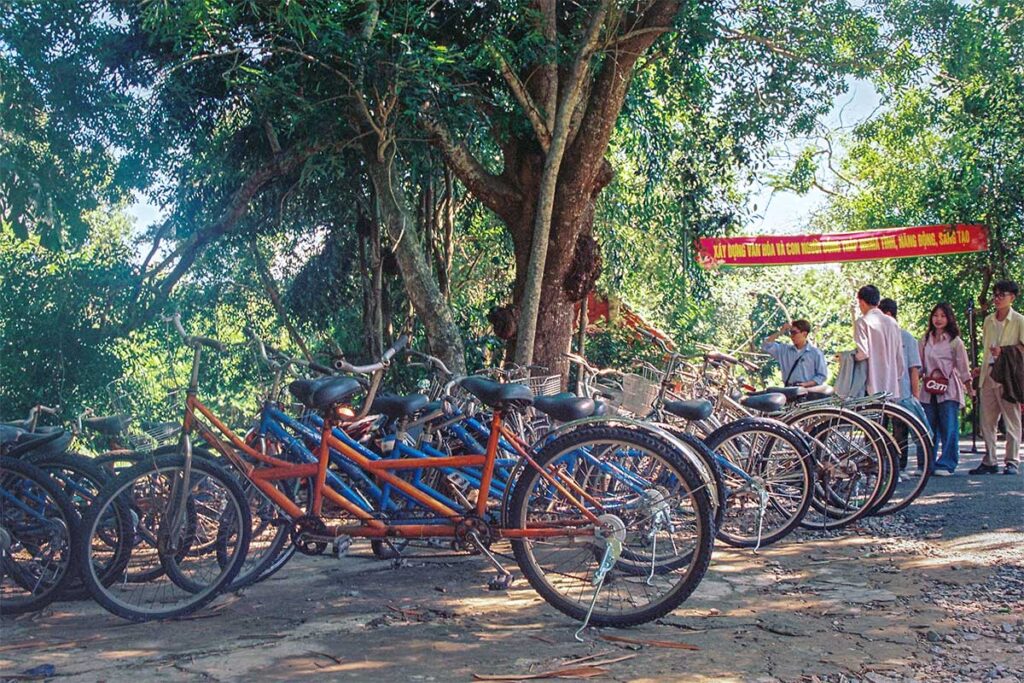
Bicycles can be rented for around 15,000–30,000 VND, giving you a relaxed way to see the forest and surrounding area. Cycling works well for reaching the lotus ponds and open paths, though not all areas inside the relic zone allow bikes. For photography or a quick circuit, it’s worth it, but walking or boating still gives you a fuller sense of the forest.
5. Lotus lakes & Ponds
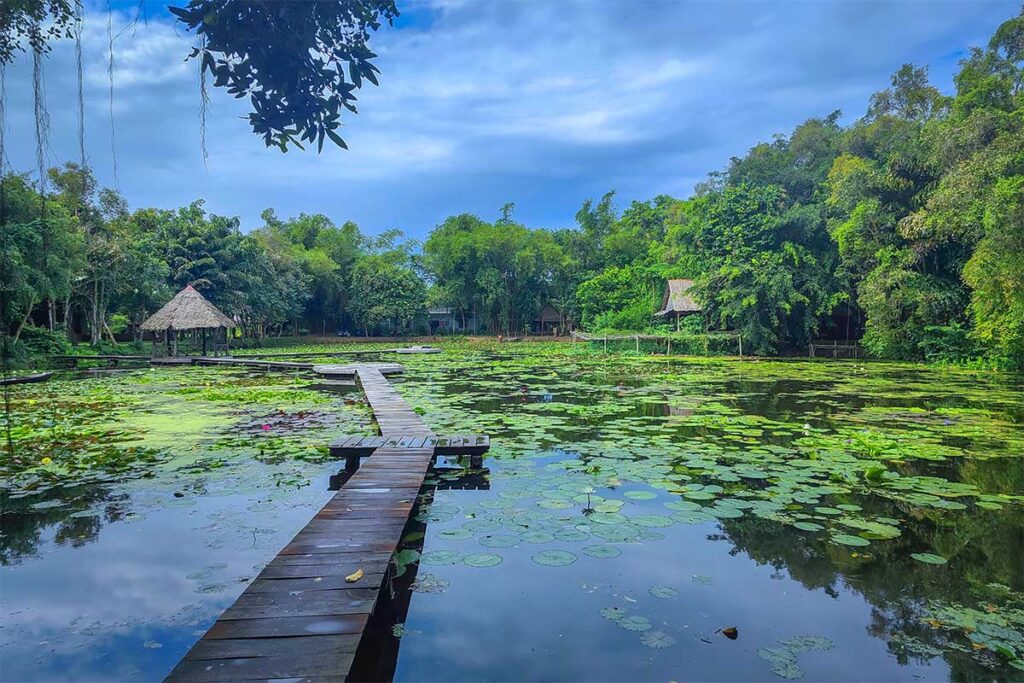
One of the most photogenic spots at Xeo Quyt is the lotus lake, where wooden boardwalks stretch out across the water. If you visit during the blooming season, the pink flowers stand out beautifully against the green pads. Even outside the peak season, the ponds make a peaceful stop for photos or a short rest in one of the shaded huts nearby.
6. Basket weaving & Local crafts
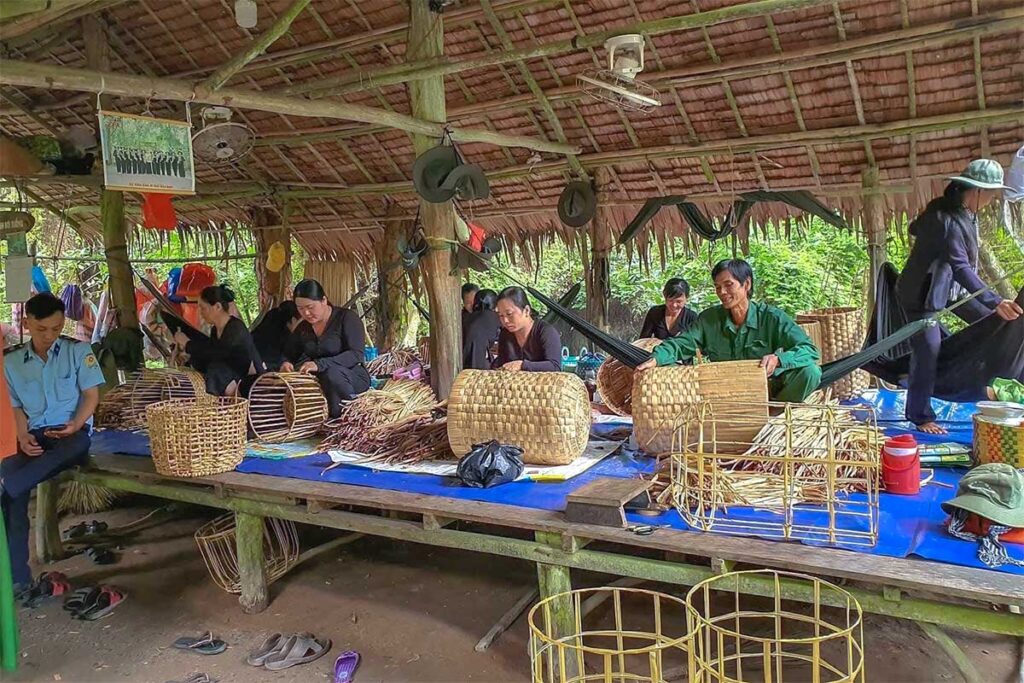
At certain times, you may also see demonstrations of traditional basket weaving. There’s a small shop selling locally made products, which makes for a low-key souvenir stop. It’s not a major attraction, but it does give a bit of cultural context alongside the forest and war relics.
How to get there
Where is Xeo Quyt Forest?
Xeo Quyt Forest is located in Hamlet 4, My Hiep Commune, Cao Lanh District, Dong Thap Province. It sits about 15 km from Sa Dec (roughly a 45-minute drive), 68 km from Can Tho, and 147 km from Ho Chi Minh City. Most travelers combine a visit with Sa Dec or as part of a broader Dong Thap itinerary. From Ho Chi Minh City, the easiest way to reach Sa Dec is by bus or private car, taking around three to four hours.
Getting there
Once you are in Sa Dec, getting to Xeo Quyt Forest is straightforward. Here are the main options for the final stretch:
- Private car with driver: The most convenient option, especially if you want to combine Xeo Quyt with Sa Dec or Tram Chim National Park. A driver can wait for you and cover multiple stops in one day.
- Taxi: From Cao Lanh, a taxi ride with waiting time costs around 800,000 VND. It’s fine for a simple return trip but less flexible than arranging a driver.
- Motorbike rental: Costs about 120,000–200,000 VND per day. The roads to Xeo Quyt are quiet and generally safe, making this a good choice if you’re comfortable riding and have a valid license.
- Motorbike taxi (xe ôm): An inexpensive and flexible option if you don’t want to ride yourself, though it’s less comfortable for longer distances.
- Navigation: Google Maps works well in the area. Roads are straightforward, with few turns once you leave the main highway.
Practical visitor information & Tips
Opening hours & Fees
Xeo Quyt Forest is open daily from 07:30 to 16:30.
- Entrance fee: 20,000 VND per person
- Sampan boat ride: 25,000–50,000 VND per person
- Bicycle rental: 15,000–30,000 VND
The prices are inexpensive, but small extras like boat rides and bike rental are usually paid separately on site.
Best time to visit
The forest can be visited year-round, but the atmosphere changes with the seasons.
- Summer (lotus season): ponds are full of blooming pink flowers, making the boardwalks especially photogenic.
- October–November (flooding season): canals are fuller, creating a wilder and more immersive boat experience.
- Dry months: trails are easier to walk and less muddy.
- Rainy months: more atmospheric, but you’ll need good shoes.
Facilities
For a relatively small site, Xeo Quyt is well set up for visitors. There is a parking lot, restrooms, and a souvenir shop near the entrance. A food court and restaurant serve local Dong Thap specialties such as grilled snakehead fish wrapped in lotus leaves or dishes made with lotus seeds. Facilities are simple but convenient if you plan to spend a few hours here.
Tips
- Mosquito repellent: essential, especially if you’re on the boat or visiting in the wet season.
- Water & snacks: bring your own or buy at the entrance area.
- Footwear: comfortable shoes that can handle mud are best.
- Language: English is limited; guides are often locals who share personal or family war stories in Vietnamese. A translator or Vietnamese-speaking friend helps, but even without, the visit is still worthwhile.
- Expectations: this is not a wildlife park—don’t expect bird spectacles or big animal encounters. Come for the scenery and history.
- Weather: the shaded forest helps, but it’s still hot and humid; pace yourself.
Nearby attractions
There isn’t much immediately around Xeo Quyt, so most travelers combine it with other Dong Thap highlights:
- Sa Dec Flower Village (15 km): colorful flower farms, best in bloom season.
- Huynh Thuy Le Ancient House: French-Chinese heritage house in Sa Dec.
- Tram Chim National Park (62 km): the province’s best birdwatching site.
- Thap Muoi Lotus Fields (22 km): vast lotus landscapes, especially pretty in summer.
Is Xeo Quyt Forest worth visiting?
Xeo Quyt Forest is worth a visit if you’re interested in a mix of history and nature. The peaceful sampan rides and shaded trails combined with hidden bunkers make it quite different from other destinations in the Mekong Delta. What you won’t find here are large wildlife spectacles or dramatic landscapes — it’s more about quiet scenery and a slice of Vietnam War history.
For most travelers, Xeo Quyt works best as part of a broader Dong Thap itinerary. Combine it with Sa Dec’s flower villages and heritage houses, or add a day trip to Tram Chim National Park for birdwatching. On its own, it may feel a bit small, but as part of a wider trip, it’s an interesting and worthwhile stop.
